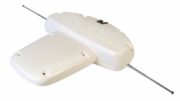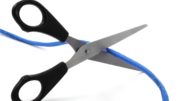It’s been brought up to me that making antenna masts out of steel could potentially have a negative effect on reception. The argument is either that the mast blocks the signal or that it changes the reception pattern my nature of its even being there. So, it seems like a great subject for an article.
So you’re saying steel masts are a problem?
I’ll counter that two ways: First of all if you’re using a Yagi-type or omnidirectional antenna you’re mounting it on the top of the mast where there’s less chance of interference anyway. If you’re using a UHF antenna it probably mounts on the front of the mast so it’s not an issue either. The other thing I’ll generally point out is that antenna manufacturers, at least the smart ones, will take the design of the mast into account when designing the antenna.
Non-steel options
But let’s indulge ourselves for a moment. If you’re worried most about the mast itself actually interfering with the reception pattern of the antenna then you’d probably want the mast to be something non-conductive but as strong as possible. Carbon fiber would probably be a good material for this, or if you’re feeling less exotic, fiberglass. You’d probably want something really firm in the center to limit the amount of flexing, possibly a ceramic of some sort. Putting aside for a moment that your mast would probably cost $500, that would solve that theoretical problem.
Is the mast really a problem?
What about those who say that the mast blocks part of the signal? For those folks I’d propose an acrylic or tempered glass post, not round but rectangular like a 2×4. It would need a low refractive index so that it wouldn’t bend the transmissions passing through it. Whatever they make the windows on spaceships out of is probably a good candidate there. So now you’re probably at $2,000 for a mast, but hey we’re just having fun here.
I mean, really, if you’re truly interested in a perfect solution, how about no mast at all? I wonder if you could rig a series of high-power magnets to keep an antenna in position? The magnetic field could warp the signal when it’s passing through, though. Maybe a series of cables made from carbon nanotubes. Nanotubes can be made into super-strong, super-thin fibers and might work.
OK now, this is getting silly.
Maybe, you could build a pyramid out of something non-conductive and transparent to RF like that white plastic they put on the back of some smartphones. Actually, even better, make it shaped like a 3D version of the Atari logo so it could be really thin at the top. I bet you could 3D print something like that, or maybe cast it using a giant mold.
Wait, does it seem like I’m getting way off track and venturing into the realm of the absolutely ridiculous? That’s because I am. Folks, antenna masts can be steel or aluminum or whatever; as I said the antennas are designed so that the mast has little or no effect on them. But hey, it’s fun to dream.
Seriously though…
If you do need an antenna mast, or a whole new antenna, shop the great selection at Solid Signal.





